Giant walker
We will meet one of the most surprising animals found in the unit: the elephant. He knows that he is not able to disturb any other animal and therefore his attitude will radiate security.
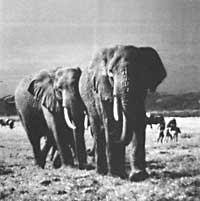
We will meet one of the most amazing animals in the world: the elephant.
When he is in a group, slow, calm, owner of his greatness, the elephant runs through the plains. He knows that he is not able to disturb any other animal and therefore his attitude will radiate security. Horn, to one side and to another, touch, catch, drive, etc. performs. It owns extensive land. However, we are not fixed in one place. It is really tireless. Unlike other animals, it is not enough with a specific and limited territory. In one way or another it behaves as if it were owner of the whole territory, without haste, crossing it without any gravity.
The volume of the elephant surprises us, especially because of the impression of power generated by this mass. However, for us the most curious thing is his horn.
The elephant horn performs many functions. It serves everything: working tool (collection of high branches or transfer of weights, obtaining food or palpation of an unknown body), odor appendix, tube that fills the body with water or dust to shower... The elephant would not be all without the perfection of the horn. In addition to smelling, it performs various functions. It is undoubtedly the most developed organ in the evolution of this animal.
Therefore, the horn is his hand, but a very special hand, because in it he has the senses of taste and smell. That is, certainly a tool rich in the perception of the environment.
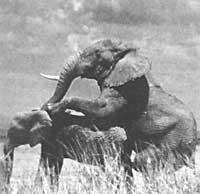
The African elephant has two lips at the end of the horn. They are like fingers and with them acquires anything, however small, without big mistakes and with surprising water ambition. On the one hand it is sensitive, but on the other, what a force! The clearing horn can become hard, capable of hitting perfectly or plucking trees. Once the horn is received, it gathers the messages that come quietly in the air, using them as wind gusts or as smells. During droughts you can find water in the subsoil of the tube, opening new sources and benefiting other animals.
Let's analyze the movements of the horn. As a snake moves in all directions and adopts all forms: it rolls or relaxes, lowers (to catch a xagutxo on the earth's surface) or stretches (to the upper branches of a tall tree). Therefore, the tube can explain any posture. Through this versatile sensitive organ, the whole body (mass of pure power) is well informed of the medium.
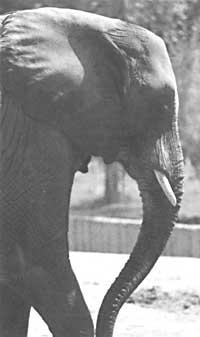
The African elephant has its large ears very remarkable. Its function is to achieve temperature balance. This animal fans its ears to dissipate the solar heat it suffered at noon. The ears are formed by a closed grating of capillary tube that allows to eliminate the excess heat accumulated inside. However, when it is not hot, it keeps the ears standing and glued to the body.
To maintain such a large body (the weight is 6 tons) the amount of food is not a joke. The elephant needs 300 kg of food a day. That may be the reason why this animal can be strolling. If it were stationary, a group of elephants would quickly exhaust all the resources of a place.
The legs of the elephant seem consistent and monolithic, like four columns. We can also consider these sections of great evolution. Thanks to these legs can circulate on any type of terrain. The lower leg adapts to all irregularities and ensures the balance of all that mass. It is not surprising to see the elephant moving on steep slopes. But you can't jump.
In addition, this animal also knows how to swim. The water is eager and the bath becomes rite. Often the group goes to a water well, where elephants fly, shower, play... It is clearer that they like it. If the river or lake is too deep, you can breathe under the tube with the whole body submerged.
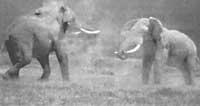
For all this, it is clear that the elephant has important social habits. They usually form a group. The head of the group is not a male, but a female, and the oldest of them. This guides all who respect their authority. Males live quite far from others (females and adolescents).
There are also lonely elephants. They are usually the oldest abandoned. The latter do not lose all relationships with their relatives. To the old and lonely elephant, some young help him escort.
Because of their volume, strength and weight, the attacks of the elephant are really terrifying. But who brings this miracle out of his laziness? If someone or nothing breaks your tranquility or your customs, something terrible can happen. The rest of the animals know it and do not put obstacles to avoid problems. If someone showed his courage, the elephant appears ready to fight. To do this, use your tubes and fangs.
It is difficult to need them. The hazard or threatening gesture is usually sufficient at most or intended to attack
show that the brave enemy is wrong. Therefore, this form of force provides good performance.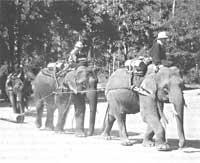
The fight does not begin and is “convinced” of lions, leopards and other enemies; fighting the elephant would be a terrible madness.
Those good fangs he has are not really canines, but incisors. Throughout the century they have been the main causes of death of this animal. Boli! The wildest places in Africa crossed to get ivory. The hunters were very well paid… As always, this powerful animal has had man as its main enemy.
In some countries, this giant has gone from being a wild animal to becoming a pet thanks to its ability to learn things quickly. His good conditions and safety have provided him with a means to develop his brain a lot. The expression “elephant memory” makes it clear to us its ability to accumulate information. It seems that his psyche is balanced and has the ability to give answers to different situations.
Likewise, the elephant is one of the most important “companions” among animals. An example of this is the Indian elephant. They are territories in which human aid is faithful and necessary.
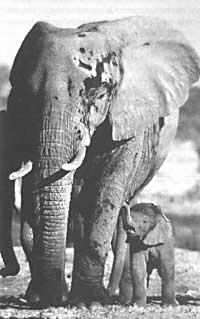
The Indian elephant has some differences with its African relative. The eastern one is smaller, the ears are much smaller and wrapped (since they just have to fulfill the function of fan), the canines of the females are not exposed and the male has much less than the African. The Indian Proboszideo is a common farmhouse used for all types of transport and services.
In India, one of the oldest rural sports is the fight between elephants. Through the stimulation and provocation of the testers are put in struggle against the nature of the animals. For this, human participation is necessary, since they renounce the struggles between relatives.
Through these lines we have been able to see and learn some curiosities. Proboszideo is one of the most honored animals of creation. That is our ELEPHANT.
Buletina
Bidali zure helbide elektronikoa eta jaso asteroko buletina zure sarrera-ontzian












